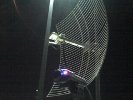|
Short answer: The current software does isolated mesh networks now with no code changes. If you want two or more separate BBHN based mesh networks, just change the SSID, and the two networks will ignore each other. i.e. Just change the SSID on nodes in your "isolated" mesh network to be "MESH-B" and leave your "general access" mesh nodes with the default "BroadbandHamnet-v1" and you now have two separate mesh networks that won't see each other at all. SSID is a parameter on the setup page for the mesh nodes in BBHNv1.
No code changes needed, works on all the current platforms as is, no compatibility problems with existing nodes, no need to come up with BBHNv2 and make everyone update the firmware on all their existing nodes. Long answer:
The olsrd-secure mechanism is intended for keeping out malicious people trying to infiltrate your network, and, IMHO, imposes an unnecessary level of complexity if you're just trying to define two networks. Olsrd-secure probably doesn't do as good a job of isolating the two networks, either, because if the SSID is the same, "wrong key" nodes would still try to connect and then fail to authenticate. If you wanted two isolated networks, you'd want to change the SSID even if you use a separate olsrd-secure key. Olsrd-secure and different keys only makes sense if you're worried about a malicious person with a standard BBHN mesh node trying to break into your isolated network. Remember, that anyone who can receive your isolated BBHN network can still monitor all the traffic, even if they don't know anything about BBHN, mesh, OLSR, or OpenWRT. The data isn't encrypted, even with olsrd-secure, and there are plenty of free network tools that will log everything.
I'm concerned about the idea of adding olsrd-secure back into the system.
When we had olsrd-secure enabled in the 0.4.3 release of HSMM-MESH, it caused a lot of problems with porting new hardware due to big endian problems. I'm not sure all those issues are resolved. If you put olsrd-secure into the Ubiquiti devices, you might break compatibility with WRT-54G and other existing "ports" in ways that aren't necessarily easy to fix. Don't forget that there are a lot of "ports" of BBHN, other than just WRT and Ubiquiti. I know people have ported to Raspberry Pi. I think some people have even managed to connect from Windows PCs, but the code used is very old. The olsrd-secure plugin has been a big problem in the past with endian problems between problems. In particular, some of the endian problems may be resolved in the latest versions of the OLSR/OpenWRT code, but the fixes may not be available for all hardware platforms, or may require you to upgrade all the firmware components to the latest level. Even if you do get all the firmware updated for all platforms, then everyone has to go and reflash their mesh nodes again. Some people have problems with the process. Some nodes are not easy to access to update. Sometimes, you brick the mesh node when you flash it.
(Note: by "ports," I mean someone has been able to make device X connect to HSMM-Mesh or BBHN networks, not that it's a slick, complete, easy to install distribution like the WRT54G or Ubiquiti packages.)
[kd0ebt 2014-03-26- 15:42:04]: In considering an emergency situation, would a particular area MESH want to be isolated anyway from the general MESH network. I am shooting big here because I think this will definitely take off as the new avenue in Amateur Radio. As regions start to connect, won't we want the MESH up and running for "general amateur radio use" and allow for a particular group to utilize a scalable MESH for different public service and emergency communications that would not receive unintentional interference from the greater Broadband Hamnet. I realized that I may have slid off the discussion a bit, but maybe specialized use of the MESH could use the keys. They would be the more functional and super user level operators in the MESH. |
